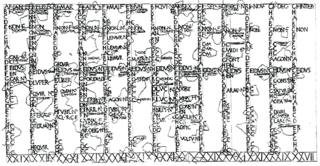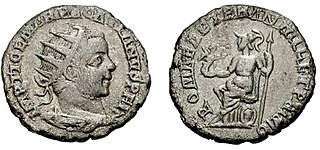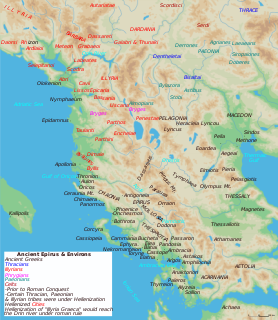
The traditional China calendar, or Former Calendar, Traditional Calendar or Lunar Calendar, is a lunisolar calendar which reckons years, months and days according to astronomical phenomena. It is defined by GB/T 33661-2017, "Calculation and promulgation of the Chinese calendar", issued by the Standardisation Administration of China on 12 May 2017.
The Julian calendar, proposed by Julius Caesar in 46 BC, was a reform of the Roman calendar. It took effect on 1 January 45 BC, by edict. It was the predominant calendar in the Roman world, most of Europe, and in European settlements in the Americas and elsewhere, until it was refined and gradually replaced by the Gregorian calendar, promulgated in 1582 by Pope Gregory XIII.

Year 27 BC was either a common year starting on Sunday, Monday or Tuesday or a leap year starting on Monday of the Julian calendar and a common year starting on Sunday of the Proleptic Julian calendar. At the time, it was known as the Year of the Second Consulship of Octavian and Agrippa. The denomination 27 BC for this year has been used since the early medieval period, when the Anno Domini calendar era became the prevalent method in Europe for naming years.
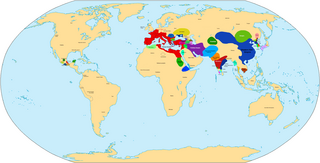
AD 1 (I), 1 AD or 1 CE is the epoch year for the Anno Domini calendar era. It was the first year of the Common Era (CE), of the 1st millennium and of the 1st century. It was a common year starting on Saturday or Sunday, a common year starting on Saturday by the proleptic Julian calendar, and a common year starting on Monday by the proleptic Gregorian calendar. In its time, year 1 was known as the Year of the Consulship of Caesar and Paullus, named after Roman consuls Gaius Caesar and Lucius Aemilius Paullus, and less frequently, as year 754 AUC within the Roman Empire. The denomination "AD 1" for this year has been in consistent use since the mid-medieval period when the anno Domini (AD) calendar era became the prevalent method in Europe for naming years. It was the beginning of the Christian/Common era. The preceding year is 1 BC; there is no year 0 in this numbering scheme. The Anno Domini dating system was devised in AD 525 by Dionysius Exiguus.
Year 1 BC was a common year starting on Friday or Saturday of the Julian calendar and a leap year starting on Thursday of the Proleptic Julian calendar. It is also a leap year starting on Saturday, in the Proleptic Gregorian calendar. At the time, it was known as the Year of the Consulship of Lentulus and Piso. The denomination 1 BC for this year has been used since the early medieval period, when the Anno Domini calendar era became the prevalent method in Europe for naming years. The following year is 1 AD in the widely used Julian calendar, which does not have a "year zero".
Year 7 BC was a common year starting on Saturday or Sunday of the Julian calendar and a common year starting on Thursday of the Proleptic Julian calendar. In the Roman world, it was known as the Year of the Consulship of Nero and Piso. The denomination 7 BC for this year has been used since the early medieval period, when the Anno Domini calendar era became the prevalent method in Europe for naming years.
Year 8 BC was either a common year starting on Friday or Saturday or a leap year starting on Thursday of the Julian calendar and a common year starting on Wednesday of the Proleptic Julian calendar. At the time, it was known as the Year of the Consulship of Censorinus and Gaius Asinius. The denomination 8 BC for this year has been used since the early medieval period, when the Anno Domini calendar era became the prevalent method in Europe for naming years.
Year 63 BC was a year of the pre-Julian Roman calendar. At the time it was known as the Year of the Consulship of Cicero and Hybrida. The denomination 63 BC for this year has been used since the early medieval period, when the Anno Domini calendar era became the prevalent method in Europe for naming years.
Year 138 BC was a year of the pre-Julian Roman calendar. At the time it was known as the Year of the Consulship of Serapio and Callaicus and the Third Year of Jianyuan. The denomination 138 BC for this year has been used since the early medieval period, when the Anno Domini calendar era became the prevalent method in Europe for naming years.
Year 399 BC was a year of the pre-Julian Roman calendar. At the time, it was known as the Year of the Tribunate of Augurinus, Longus, Priscus, Cicurinus, Rufus and Philo. The denomination 399 BC for this year has been used since the early medieval period, when the Anno Domini calendar era became the prevalent method in Europe for naming years.
Year 182 BC was a year of the pre-Julian Roman calendar. At the time it was known as the Year of the Consulship of Tamphilus and Macedonicus. The denomination 182 BC for this year has been used since the early medieval period, when the Anno Domini calendar era became the prevalent method in Europe for naming years.
The year 521 BC was a year of the pre-Julian Roman calendar. In the Roman Empire, it was known as year 233 Ab urbe condita. The denomination 521 BC for this year has been used since the early medieval period, when the Anno Domini calendar era became the prevalent method in Europe for naming years.

The ancient Egyptian calendar was a solar calendar with a 365-day year. The year consisted of three seasons of 120 days each, plus an intercalary month of 5 epagomenal days treated as outside of the year proper. Each season was divided into four months of 30 days. These twelve months were initially numbered within each season but came to also be known by the names of their principal festivals. Each month was divided into three 10-day periods known as decans or decades. It has been suggested that during the Nineteenth Dynasty and the Twentieth Dynasty the last two days of each decan were usually treated as a kind of weekend for the royal craftsmen, with royal artisans free from work.
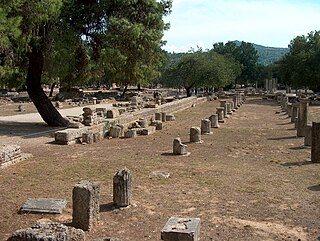
An Olympiad is a period of four years associated with the Olympic Games of the Ancient Greeks. Although the Ancient Olympic Games were established during Archaic Greece, it was not until the Hellenistic period, beginning with Ephorus, that the Olympiad was used as a calendar epoch. Converting to the modern BC/AD dating system the first Olympiad began in the summer of 776 BC and lasted until the summer of 772 BC, when the second Olympiad would begin with the commencement of the next games. By extrapolation to the Gregorian calendar, the 3rd year of the 699th Olympiad began in (Northern-Hemisphere) mid-summer 2019.
A calendar era is the year numbering system used by a calendar. For example, the Gregorian calendar numbers its years in the Western Christian era. The instant, date, or year from which time is marked is called the epoch of the era. There are many different calendar eras such as Saka Era.
The Holocene calendar, also known as the Holocene Era or Human Era (HE), is a year numbering system that adds exactly 10,000 years to the currently dominant numbering scheme, placing its first year near the beginning of the Holocene geological epoch and the Neolithic Revolution, when humans transitioned from a hunter-gatherer lifestyle to agriculture and fixed settlements. The year 2019 in the Holocene calendar is 12,019 HE. The HE scheme was first proposed by Cesare Emiliani in 1993.
Year zero does not exist in the anno Domini system usually used to number years in the Gregorian calendar and in its predecessor, the Julian calendar. In this system, the year 1 BC is followed by AD 1. However, there is a year zero in astronomical year numbering and in ISO 8601:2004 as well as in all Buddhist and Hindu calendars.
The Kurdish calendar was originally a lunisolar calendar related to the Babylonian calendar, but is now a solar calendar related to the Iranian calendar. The current year will begin on 21 March 2019.
The Gregorian calendar is the most widely used civil calendar in the world. It is named after Pope Gregory XIII, who introduced it in October 1582. The calendar spaces leap years to make the average year 365.2425 days long, approximating the 365.2422-day tropical year that is determined by the Earth's revolution around the Sun. The rule for leap years is:
Every year that is exactly divisible by four is a leap year, except for years that are exactly divisible by 100, but these centurial years are leap years if they are exactly divisible by 400. For example, the years 1700, 1800, and 1900 are not leap years, but the year 2000 is.
